All You Need to Know About Ho Chi Minh Museum in Hanoi: History, Hours, and Tickets
Anyone who is keen to understand more about Vietnam’s revolutionary past and the life of its adored leader, Ho Chi Minh, has to visit the Ho Chi Minh Museum in Hanoi. This museum is a monument to the man guiding the nation through some of its most significant events and a lighthouse for people trying to comprehend Vietnam’s fight for independence. Let MOTOGO Tours explore
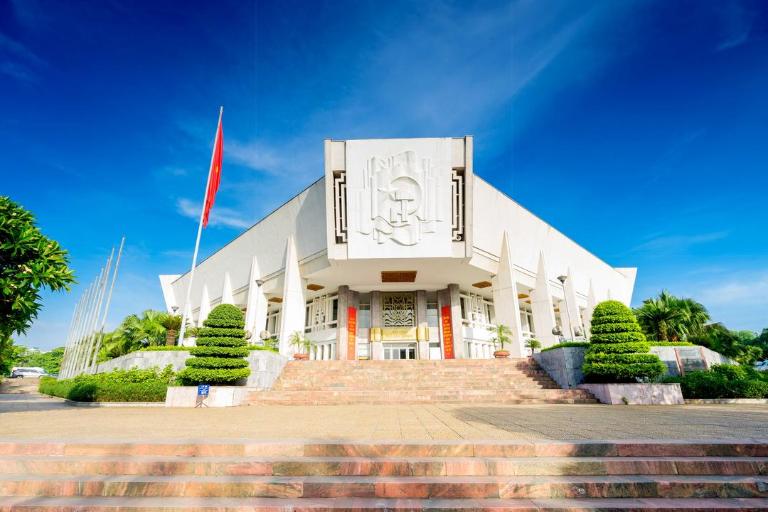
Background of Ho Chi Minh Museum
You really need know the rich historical background of the Ho Chi Minh Museum before entering it. The museum represents a live reminder of Vietnam’s struggle for independence and the legacy of its most famous leader, not only a storehouse of relics.
Beginning and the museum’s goals
Opening on September 2, 1990, the Ho Chi Minh Museum commemorated the 100th anniversary of Ho Chi Minh’s birth and aligned with Vietnam’s National Day. Its main objective is to honor and protect the life and accomplishments of Ho Chi Minh, the man who founded contemporary Vietnam. The museum was constructed to give residents and visitors a place to consider the ideals Ho Chi Minh stood for—freedom, equality, and national unity.
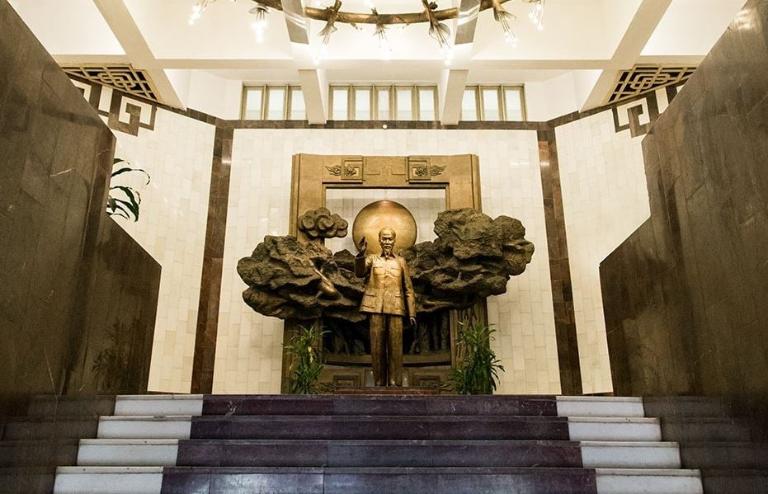
Ho Chi Minh Museum’s architectural wonder
Modernist ideas mixed with traditional Vietnamese aesthetics define the museum’s design. Architecturally, it is like a flowering lotus, signifying purity, hope, and resiliency—qualities most closely related with Ho Chi Minh. In the Ba Dinh area of Hanoi, the building’s angular design and minute detailing set it out.
First floor – displays on the biography of Hồ Chí Minh
Visitors are met by an amazing brass portrait of President Ho Chi Minh as soon as they walk into the first floor lobby. Following this is an exhibition space including pictures, records, and relics concerning his life together with important turning points in his revolutionary career and the nation’s building under his will. There are nine main themes running across the exhibition:
- Theme 1: Exhibits of relics and pictures that replicate his childhood and youth biography from Nghe An, 1890 to 1910.
- Theme 2: Ho Chi Minh’s difficult search for a means of saving the country—traveling across several nations between 1911 and 1920—is shown in this section. He performed several jobs throughout this period while still in school and investigating the road to national freedom.
- Theme 3: Photographs and records of Ho Chi Minh’s stay in France are gathered and on show.
- Theme 4: Visitors can peruse records on the development of Hồ Chí Minh’s philosophy and the pragmatic efforts resulting in the founding of the Communist Party in Vietnam.
- Theme 5: Objects from the fight to create the Party and acquire freedom abound in this part. It also shows records on his revolutionary actions and incarceration in Guangxi and Hong Kong.
- Theme 6: Objects from this era enable guests to better grasp Ho Chi Minh’s life during the nine-year struggle in the Northwest mountains between 1945 and 1954, therefore safeguarding the fledgling government.
- Theme 7: Materials connected to his diplomatic actions, the growth of the nation in the North, and the Southern independence movement abound in this space.
- Theme 8: On exhibit are records on Ho Chi Minh’s last years and 1969 death.
- Theme 9: This subject gathers his revolutionary activities and the legacy President Ho Chi Minh left for the country.
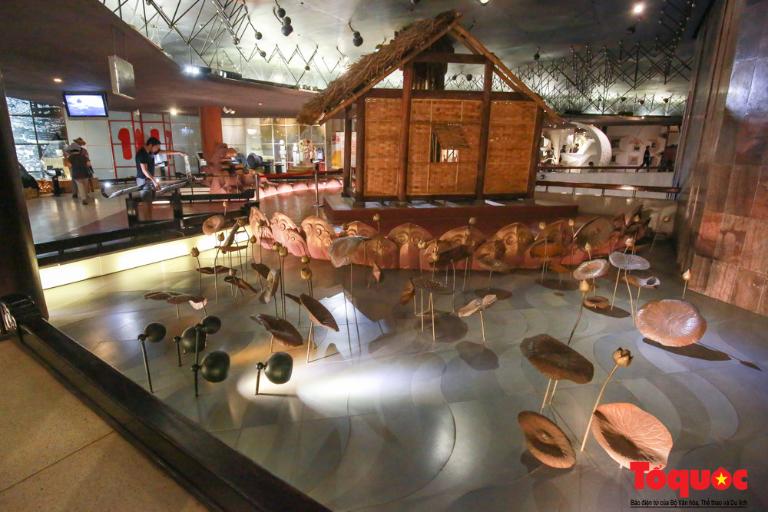
>>> Let’s see more: Discover the Hanoi Museum: A Journey Through Vietnam’s History
Second floor: Recreating the glorious victories of the people led under Ho Chi Minh
The first floor’s themes are carried on to let guests better grasp the fight for freedom and the tremendous successes led by Ho Chi Minh. The displays also show the circumstances in Vietnam and the world at the time as well as the importance of the Russian October Revolution.
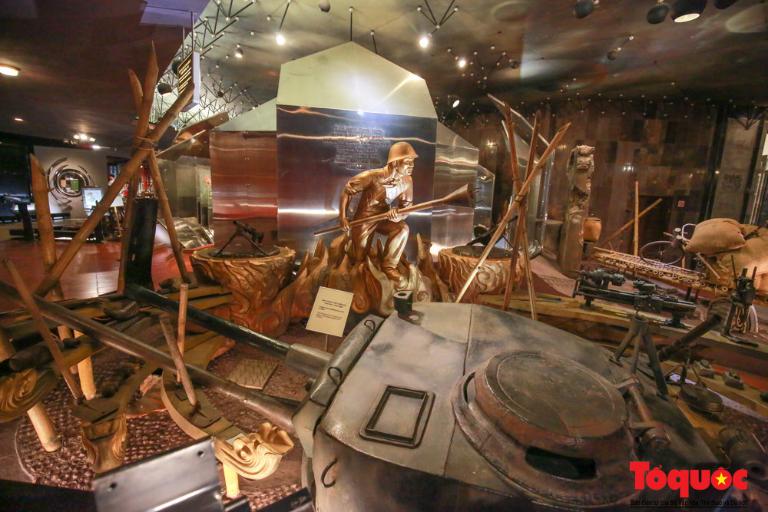
The second level also emphasizes Vietnam’s involvement with the Allies against fascism and Ho Chi Minh’s part in the worldwide revolutionary struggle. Second level remaining space is set aside for Vietnamese relic from the age of renewal.
Third floor: Important historical events in Ho Chi Minh’s life
The Ho Chi Minh Museum’s third level houses a unique display on significant historical events both locally and internationally. These occasions had a significant influence on the philosophy and behavior of the youthful Nguyễn Tất Thành on his path to be the esteemed leader of the Vietnamese people.
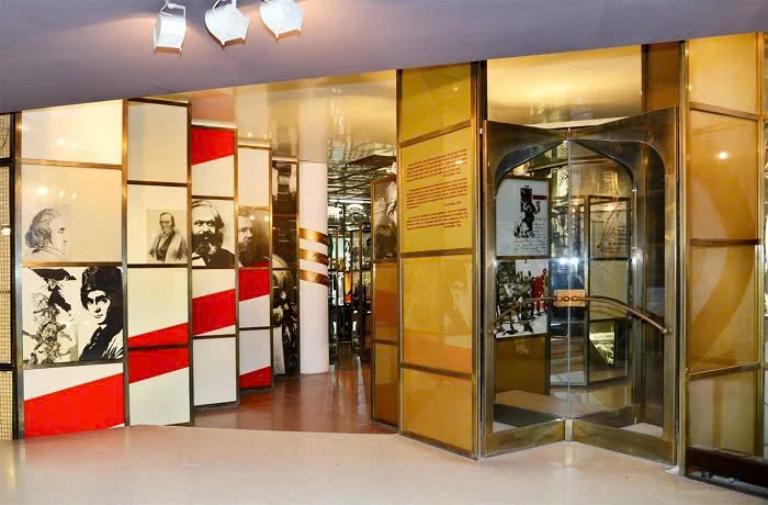
What might one expect at Ho Chi Minh Museum?
Visiting the Ho Chi Minh Museum transports you right away to a turbulent 20th century story of Vietnam. From personal items of Ho Chi Minh to battle relics, the museum presents a perceptive trip through time.
Important Showpieces on Showfront
Beginning from Ho Chi Minh’s early life, travels across the globe, and leadership throughout the struggle for Vietnamese independence, the museum’s displays are set in chronological sequence. The objects chronicle the life of a man committed to his country and people.
Ho Chi Minh’s Personal Items
The exhibit of Ho Chi Minh’s personal items is among the most arresting parts of the museum. From his understated wardrobe to his scribbled notes, every object offers a window into his simplicity and humility of way of life. Among the things that expose a guy committed to his work—often sacrificing personal comfort for the greater good—his glasses, sandals, and inkpot.
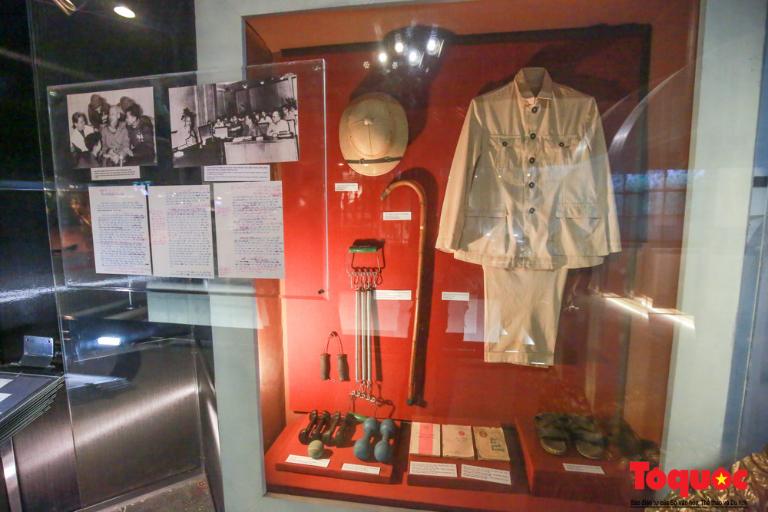
Documents and Letters
Ho Chi Minh’s papers, correspondence, and significant records abound in the museum as well. These comprise letters to other revolutionaries, political records summarizing his vision for an independent Vietnam, and personal notes capturing his ideas during pivotal points of the struggle. They offer a first-hand report of his national insight and leadership approach.
>>> Let’s see more: Vietnamese Military History Museum: A Testament to National Pride
The Symbolism of the Show Notes
Every display in the Ho Chi Minh Museum is meticulously chosen to represent pivotal events in Vietnam’s struggle for independence. Rich in symbolism, the presentations underscore the hardships and victories of the Vietnamese people. One part shows a phoenix emerging from the ashes, therefore signifying Vietnam’s reconstruction following years of war.

Eploring the surrounding area of Ho Chi Minh Museum
There is still much to see in the surrounding area, rich in historical landmarks in Hanoi, once you have explored the museum.
Ho Chi Minh Mausoleum
The Ho Chi Minh Mausoleum, where Ho Chi Minh’s body is kept and on show within a short stroll from the museum. Drawing tourists from all around the globe, this is among the most significant sites in Vietnam. The mausoleum provides a location for honoring the deceased personally, even while the museum provides insights into his life.
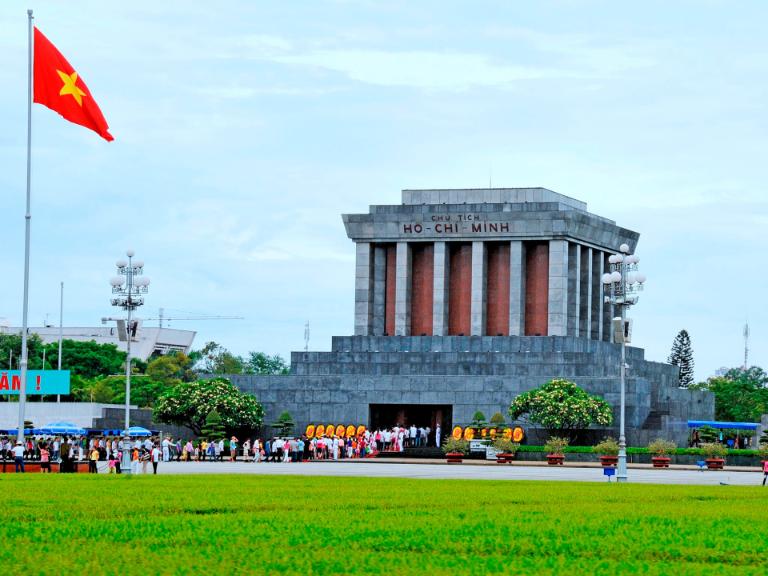
Ba Dinh Square
Ba Dinh Square, where Ho Chi Minh announced Vietnam’s freedom on September 2, 1945, lies next to the museum. With well maintained plants and a somber mood that reflects its significance in Vietnamese history, this ancient square is a great spot for a peaceful walk.
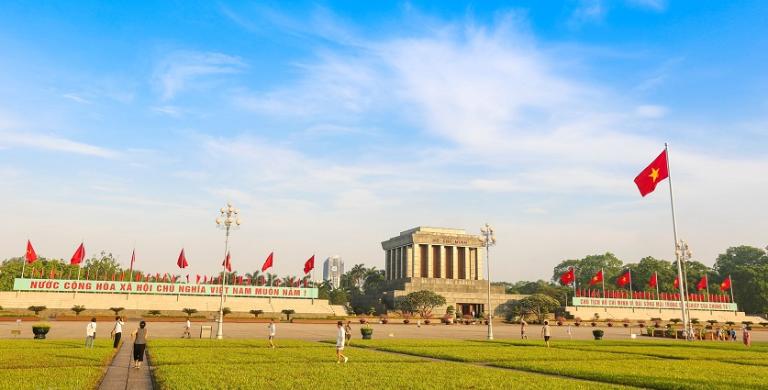
Stile House and Presidential Palace
Ho Chi Minh’s official house was the magnificent French colonial structure known as the Presidential Palace, another local site. His stilt house, a basic wooden construction where he lived and worked in later years, stands behind the palace. These websites provide a closer-up view of his life and leadership.
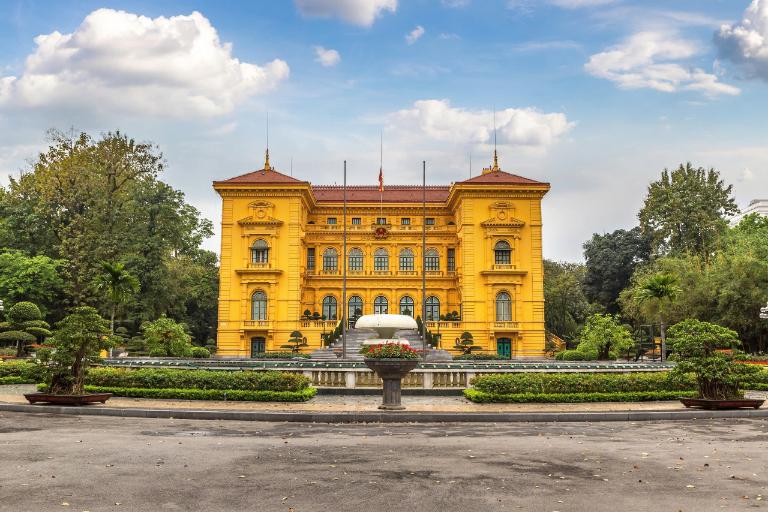
Practical Information for Visitors
Knowing the details will help you to ensure that your journey is pleasant and seamless before you start it.
Address, Entrance Charges and Ho Chi Minh Museum Opening Hour
Address: 19 Ngoc Ha Street, Doi Can Ward, Ba Dinh District, Hanoi
Hour opening times:
- Tuesday, Wednesday, Thursday, Saturday, Sunday: 8:00 AM–12:00 PM | 2:00 PM – 4:30 PM
- Monday and Friday: Closed.
The Ho Chi Minh Museum just asks foreign guests an entry price. Ticket cost: 40,000 VND/person. The following groups are free of the entrance charge:
- People from Vietnam
- People with disabilities
- International Council of Museums (ICOM) members.
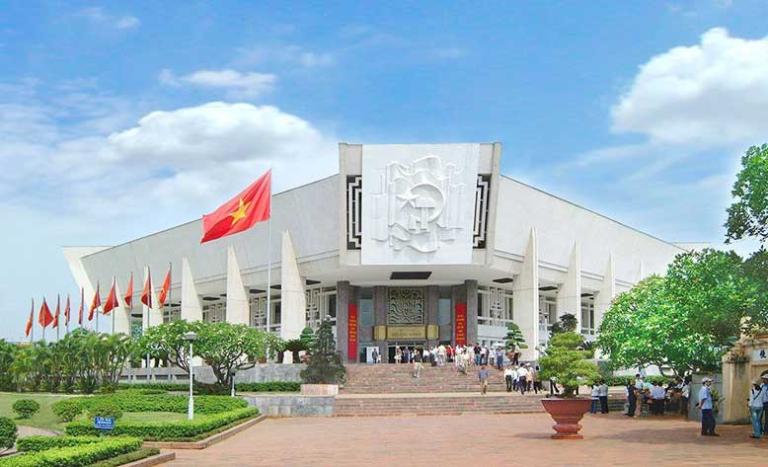
How To Get There
Situated in the Ba Dinh area of Hanoi, the Ho Chi Minh Museum is conveniently reachable from several points of view of transportation. Visitors can ride a motorbike, hail a taxi, or use the often running public buses in the vicinity. To conveniently visit Ho Chi Minh Museum and other sights, you could also rent motorbikes or join Hanoi motorbike tours.

The Ho Chi Minh Museum is a very poignant monument to the legacy of one of the most powerful presidents of Vietnam, not only a structure full of relics. Through visiting this museum, guests learn more about Vietnam’s larger fight for independence in addition to Ho Chi Minh’s life and accomplishments.
Related post:










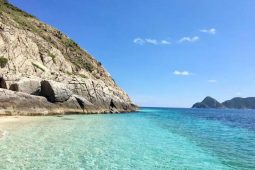

Be the first to comment!